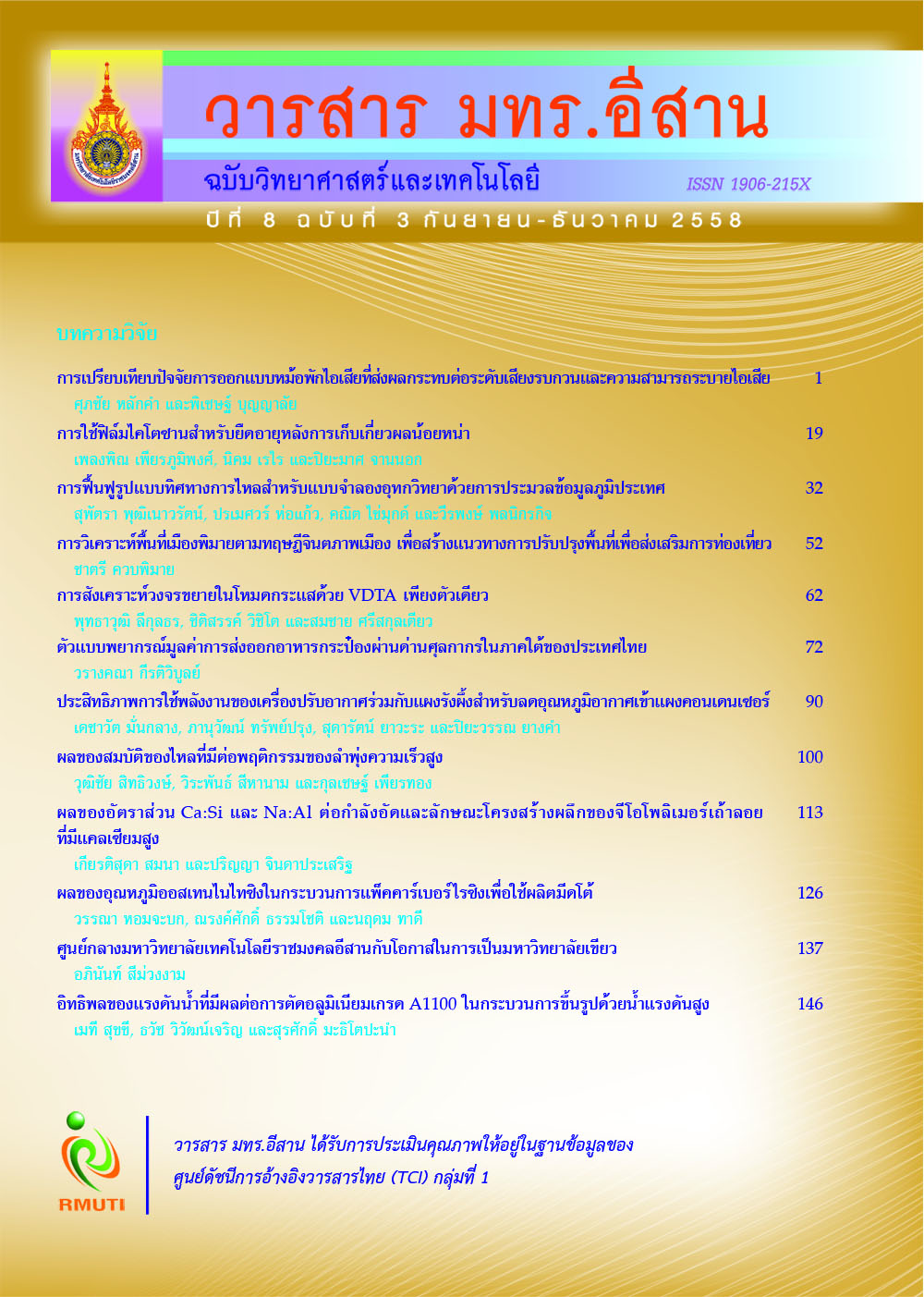อิทธิพลของแรงดันนํ้าที่มีผลต่อการตัดอลูมิเนียมเกรด A1100 ในกระบวนการ ขึ้นรูปด้วยนํ้าแรงดันสูง The Influence of Water Pressure Affect Cutting for the Grade Aluminum A1100 in the Forming Process with High Pressure Water
Main Article Content
Abstract
บทคัดย่อ
การวิจัยนี้เป็นการศึกษาอิทธิพลของแรงดันนํ้าที่มีผลต่อความเรียบผิว และค่าความฉากของชิ้นงานของ
วัสดุอลูมิเนียม A1100 โดยศึกษาแรงดันนํ้า 5 ระดับ คือ 170 200 240 275 และ 310 MPa ใช้ทราย
เป็นสารขัดขนาด 120 Mesh ชิ้นงานทดลองมีลักษณะรูปสี่เหลี่ยมผืนผ้าขนาด 10 x 40 x 25 มิลลิเมตร
ระยะยกหัวตัดจากชิ้นงานสูง 2.0 มิลลิเมตร อัตราการไหลของสารขัดอยู่ที่ 0.368 กิโลกรัมต่อนาที
วิเคราะห์ข้อมูลทางสถิติด้วยเทคนิค ANOVA จากโปรแกรมคอมพิวเตอร์
ผลการศึกษาพบว่า แรงดันนํ้าที่เปลี่ยนแปลงส่งผลต่อความเรียบผิวรอยตัดของชิ้นงาน ซึ่งแรงดันนํ้า
ที่เหมาะสำหรับการตัดวัสดุอะลูมิเนียมเกรด AA1100 คือ 170 MPa ได้ค่าความเรียบผิวดีสุด 2.53 ไมโครเมตร
และให้ค่าความฉากของชิ้นงานดีสุด 0.59 องศา อีกทั้งยังพบว่าเมื่อแรงดันนํ้าเพิ่มขึ้น ทำให้ความเรียบผิว
และค่าความฉากของชิ้นงานน้อยลง และยืนยันว่าแรงดันนํ้ามีอิทธิพลต่อความเรียบผิวและค่าความฉาก
ของชิ้นงานที่ระดับนัยสำคัญ 0.05
Abstract
This research was a study of the influences of water pressure affecting of surface
roughness and perpendicular value of work pieces of Aluminum grade A1100 with
5 levels of water pressure as: 170, 200, 240, 275 and 310 MPa by using sand 120 Mesh
as abrasives. The study was conducted on rectangular work pieces with dimension
10 x 40 x 25 mm, 2.0 mm. Stand - off distance and 0.368 kg/min of abrasive flow rate.
ANOVA statistical method was used for analysis with a computer application.
The results revealed that varied water pressures were affected to surface
roughness. The proper water pressures for cutting Aluminum grade A1100 was at
170 MPa that yielded the best of average surface roughness at 2.53 m and the
average perpendicular value of work pieces at 0.59 degrees. Moreover, it was also
found that the more increased water pressure made more increased perpendicular
value of work pieces and confirmed that water pressure influenced to the water
pressure and perpendicular value of work pieces with statistically significant level of 0.05.
Article Details
References
abrasive water jet drilling process. Materials and Design 30. Vol. 2009. pp. 810-815
Fowler G., Pashby I. R. and Shipway P. H. (2009). The effect of particle hardness and
shape when abrasive water jet milling alloy Ti6A14V. Wear. Vol. 266. pp. 613-620
Chen L., Siores E. and Wong W. C. K. (1998). Optimising abrasive waterjet cutting of
ceramic materials. Journal of Material Processing Technology. Vol. 74. pp. 251-254
Orbanic H. and Junkar M. (2008). Analysis of striation formation mechanism in abrasive
water jet cutting. Wear. Vol. 265. pp. 821-830
Boud F., Carpenter C., Folkes J. and Shipway P. H. (2010). Abrasive waterjets cutting of
a titanium alloy : The influence of abrasive morphology and mechincal properties
on workpiece grit embedment and cut quality. Journal of Materials Processing
Technology 210. pp. 2197-2205
John Rozario J. Jegaraj. and Ramesh Babu N. (2005). A strategy for efficient and quality
cutting of materials with abrasive water jets considering the variation in orifice
and focusing nozzle diameter. International Journal of Machine Tool &
Manufacture. Vol. 45. pp. 1443-1450
Hlavav L.M., Hlavacova. and Gembalova L. (2009). Experimental method for the
investigation of the abrasive water jets cutting quality. Journal of Materials
Processing Technology 209. pp. 6190-6195


